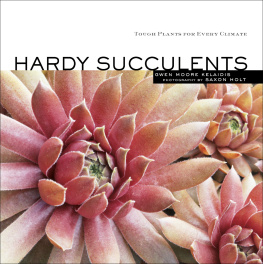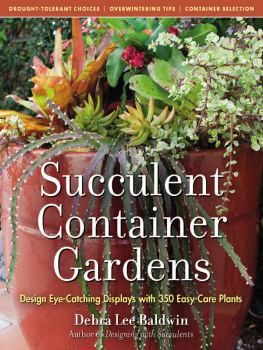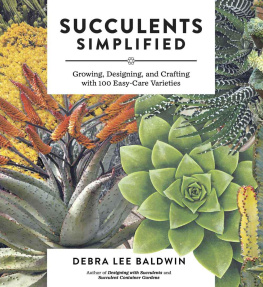HARDY SUCCULENTS

TOUGH PLANTS FOR EVERY CLIMATE
HARDY SUCCULENTS
GWEN MOORE KELAIDIS
PHOTOGRAPHY BY SAXON HOLT

The mission of Storey Publishing is to serve our customers by publishing practical information that encourages personal independence in harmony with the environment.
Text Gwen Moore Kelaidis
Photography Saxon Holt/Photo Botanic, except for the following:
Karen Bussolini, ,
All rights reserved. No part of this book may be reproduced without written permission from the publisher, except by a reviewer who may quote brief passages or reproduce illustrations in a review with appropriate credits; nor may any part of this book be reproduced, stored in a retrieval system, or transmitted in any form or by any means electronic, mechanical, photocopying, recording, or other without written permission from the publisher.
The information in this book is true and complete to the best of our knowledge. All recommendations are made without guarantee on the part of the author or Storey Publishing. The author and publisher disclaim any liability in connection with the use of this information. For additional information, please contact Storey Publishing, 210 MASS MoCA Way, North Adams, MA 01247.
Storey books are available for special premium and promotional uses and for customized editions. For further information, please call 1-800-793-9396.
Printed in China by R.R. Donnelley
10 9 8 7 6 5 4 3 2 1
Library of Congress Cataloging-in-Publication Data
Kelaidis, Gwen Moore.
Hardy succulents : tough plants for every climate / Gwen Moore Kelaidis.
p. cm.
Includes index.
ISBN 978-1-58017-700-9 (pbk. with flaps : alk. paper)
ISBN 978-1-58017-701-6 (hardcover with jacket : alk. paper)
1. Succulent plants. I. Title.
SB438.K45 2008
635.9525dc22
2007039890
Edited by Carleen Madigan Perkins and Gwen Steege
Art direction by Mary Winkelman Velgos
Cover design by Mary Winkelman Velgos based on a design by Chen Design Associates
Text design by Mary Winkelman Velgos based on a design by Chen Design Associates
Text production by Kristy L. MacWilliams
Illustrations by Beverly Duncan
Indexed by Christine R. Lindemer, Boston Road Communications
Front cover: Sempervivum Faramir
Front flap: Agave parryi, Opuntia basilaris, Sedum reflexum Blue Spruce
Back cover: Yucca thompsoniana, Sedum sieboldii Mediovariegatum, Delosperma Kelaidis
Back flap: Escobara missouriensis
3: Agave neomexicana
7, left to right: Orostachys spinosa, Sempervivum Gold Bug, Agave parryi, Opuntia engelmannii
 To all those who love plants simply for the beauty of their forms.
To all those who love plants simply for the beauty of their forms.
ACKNOWLEDGMENTS
I would like to thank all of the following people, without whom this book would not have been possible: My parents, Ouida Agnes Johnston Moore and Jesse Carl Moore, for teaching me to garden carefully and lovingly. My botany professors, Dr. John Thomson and Dr. Hugh H. Iltis, and my teacher Dr. Theodore S. Cochrane, all of the University of Wisconsin, for opening up to me the natural world in all its devastating beauty and precious variety. My fellow gardeners, especially Panayoti Kelaidis, Kelly Grummons, and Bill Adams, for sharing freely their extensive knowledge of succulents and for their generous sharing of plants. Also Lauren Springer Ogden, Barbara Cochrane, and many more. That great plantsman and nurseryman Harlan Hamernik, of Bluebird Nursery in Clarkson, Nebraska, and his wife, Shirley, for their outrageously generous donations of plants for my gardens. My friends Sandy Snyder and Marcia Tatroe and my sister, Carla Ann Young, for their continual support and encouragement of this effort.
G WEN M OORE K ELAIDIS
In pursuit of photographs to illustrate this book, I must first thank my coauthor, Gwen, who kept me focused on the hardiness factor, even when I suggested hardiness issues in my Zone 9 garden prevented me from growing kalanchoe.
Acknowledgments to the gardeners, public gardens, and homeowners who so graciously allowed me access to their gardens are on , but here I want to thank those who suggested locations and encouragement for this book: Panayoti Kelaidis of the Denver Botanic Gardens; Dan Benarcik at Chanticleer; Carlo Balistrieri; Ernesto Sandoval at the University of California, Davis; Richard Turner atPacific Horticulture magazine; Carl Schoenfeld at Yucca Do Nursery; and Gwen Steege at Storey Publishing.
Finally, thanks, Flora!
S AXON H OLT
CONTENTS




INTRODUCTION
THE GLORIES OF SUCCULENCE

LEFT: The blue-green carpet of Sedum reflexum Blue Spruce brilliantly complements the cool gray swords of Agave parryi.
Succulents have a strong pull on our imagination. Their rounded, turgid nature appeals to us, just because they are so different from most other plants in our temperate universe. The succulents of the tropics and subtropics expand our concept of what a plant should look like, morphing like Proteus into endless and highly imaginative shapes and expressions. If a tomato plant or a marigold is an average plant of average shape with average leaves, succulents represent plant forms much farther out toward the extremes of the possible expression of the plant body.
The swollen leaves have a larger presence in space; their third dimension is simply larger than that of the average leaves of most flowering plants. And many are rounded in the way that the human body is rounded, reminding us of arms or the soft, touchable swell of a childs plump cheek.
Succulents are juicy inside, and although we dont often break them open or eat them, the promise of their wetness and water storage appeals to us. We are dependent on water, and finding it in our environment is pleasing. In the dry, windy prairies of Wyoming the low, tubby balls of Coryphantha vivipara are a strong contrast to the arid grasses. Because they can store water, we are confident they will endure through the years.
In the hot deserts of the Southwest, the stout, armed forms of yuccas and agaves are stalwarts of their ecosystems. They store water as if in anticipation of hard times to come, resolutely holding their own against the vagaries of erratic rainfall, the intensity of heat, and the driving force of dust storms. We admire their strength and tenacity, their seeming ability to foresee what is to come although surely this is a case of natural selection, wherein only those that stored water survived.
Next page











 To all those who love plants simply for the beauty of their forms.
To all those who love plants simply for the beauty of their forms.



